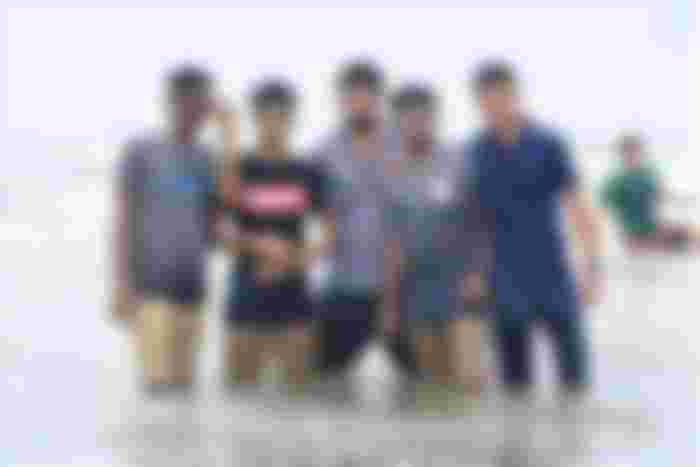Student life is the most important chapter in human life. At this time in life we get the opportunity to build our character as we wish. Although the process of acquiring knowledge of human life continues throughout life, the primary education to build one's character as a human being takes place at this time in life. Educational life does not mean just the pages of a book or the boundaries of a school.
Student life education should be comprehensive and extensive. Only then the real purpose of education becomes successful. We must become acquainted with every aspect of life in this multifaceted character of student life education. The role of educational tour in student life is undeniable in building the character of a student through that early life philosophy.
A similar educational tour was organized this year from our college. This presentation is intended to discuss in detail about that educational tour and to shed light on our educational perceptions gained from that tour.
Significance of educational tour:
Before we shed light on this year's educational tour, we need to discuss the external significance of the study tour in the lives of people, especially students. An educational tour introduces a student to the world outside the school boundaries. The connection of the nature of the world with the student through this acquaintance helps in the formation of his character.
Moreover, the role of educational tour is undeniable in determining a student's hobbies, future career and self-directed direction. What a student learns by going on a proper educational tour cannot be taught to him by the knowledge contained in the textbooks of the campus. By going on an educational tour, a student can get acquainted with the geography, climate, environment and daily life of the local people. So the perception gained from the educational tour is able to have a special impact on the whole life of a student.
Our educational tour:
Our school education tour is not new this year. Earlier, we were taken on an educational tour from college while studying in the first year. At that time, the focus was mainly on historical places, but this time the emphasis was on the overall development of students.
The overall development of a student through an educational tour is possible only when that trip has multifaceted significance. So judging from all aspects, this year the Sundarbans was selected as the relevant place for our educational tour by our college authorities.
Reason for choosing a place:
There are several reasons behind choosing the Sundarbans for our educational tour. We have learned about these reasons from our teachers. The overall development of the students was the first consideration in selecting the venue for this educational tour. The place of the visit needs to have multifaceted importance for the overall development of the students.
From that point of view, the Sundarbans is unique in terms of geography on the one hand, and on the other hand, the Sundarbans has a fair share in the diversity of flora and fauna. Moreover, the delightful experience of educational travel by water that can be gained in the Sundarbans is probably not possible anywhere else in the country. That is why the Sundarbans could be a more suitable place for our educational tour this year.
Routes and travel plans:
A total of 70 students of our year registered for the Sundarbans study tour. A bus was hired to take 10 more teachers with us. At 9 pm on October 12, we all took the bus to the Sundarbans. The next morning our bus reached Bagerhat in Khulna district and reached Mongla.
From there it is launched to the Sundarbans. On the way, our teachers explained the entire travel plan in detail to everyone. Our first destination was Jamtala beach. From there it becomes Diamond Point to Cuttack Beach. Mandarbaria beach will fall in the middle. A total of four night tour plans.
Gaining knowledge about topography:
After the launch from Mongla to the Sundarbans, the beauty of the Sundarbans began to be felt little by little. At the same time, our teachers continue to explain to everyone about the nature of the Sundarbans and its impact. From them we know that the Sundarbans is the largest saline forest in the world.
Covering an area of 10,000 square kilometers, these forests are spread between India and Bangladesh. The Sundarbans consists of the South 24 Parganas of West Bengal, India, and parts of the districts of Khulna, Satkhira, Bagerhat, Patuakhali and Barguna in Bangladesh. In 1997, UNESCO recognized the Sundarbans as a World Heritage Site.
Spread over an area of 164 sq km of the Sundarbans in Bangladesh, there are beautiful rivers and canals. Moreover, almost the entire Sundarbans is covered by dense forests. The soil here is naturally saline and the border of the Bay of Bengal will meet only if it moves a little to the south. Due to its geological location, the Sundarbans region is considered to be a paradise for various terrestrial and aquatic animals.
Forest Inspection
From Mongla to the Sundarbans in the early stages of the forest is a huge outlet. Our environmental science teacher says there are about 350 species of plants in the Sundarbans. Several of them are rare again. Due to the high salt content of the soil, most of the plants here are mangrove species. However, the most eye-catching tree here is the beautiful tree.
The mangrove is believed to have been named after this tree. Other notable trees here include Garan, Gewa and the famous Golpata tree. In the light of the sun entering through the gaps of the dense forest, you could see zucchini and acacia trees, seaweed, reed etc. Our teachers explained that the dense forest on the one hand is the primary forest character of the mangrove , on the other hand it is the forest that sets the background for the significant biodiversity of the mangrove .
Wildlife inspection experience:
While visiting the forest, I could see various unnamed birds, a couple of deer, bees hanging from the trees, etc. from time to time. Our teachers explained to us as many birds as they could. In the meantime, we came to know from the teachers that this is the famous Chitra deer of the mangrove .
Then, while visiting the beauty of the mangrove from a small beach tower, I suddenly came across many coveted Royal Bengal Tigers. Although then the Bengal Tiger met once more. The feeling of seeing a tiger is never forgotten in life. In addition, during the trip, we came across various types of unnamed animals, snakes, chameleons, etc.
Introduction to Aquatic Animals:
The third day begins our journey to the mangrove by water. Teachers tell us that the land area of the mangrove as well as the water area has a wide range of biodiversity. Due to its proximity to the mouth of the river, about 300 species of vertebrates, 12 species of crabs and shrimps, different types of snails and 6 species of amphibians have been found in the mangrove
Meanwhile, the Gangetic dolphin or dolphin Anagona was spotted from the launch. We learned from a local guide that the number of fish in the mangrove has recently decreased due to increasing pollution and other reasons. From the launch, the teachers showed us the famous crocodile of the mangrove sunbathing on the mud on the bank of the river far away. Then we reached Katka beach by launch and saw many red crabs.
One day in local life:

On the fourth or last day of the trip we spent time with the locals of the Mangrove . Strangely simple-minded locals show us around their villages, jungles, fields and so on. It was here with them that we first saw the method of collecting honey by breaking the beehive.
At this time we learned from the teachers that the people here are completely dependent on food, shelter and economically the Mangrove (Sundarbans local name). That is why the local people worship the jungle in the form of Banabibi. We have learned from them that even though the whole world is moving towards modernity, they still find the fulfillment of life in prehistoric dependence on nature.
Barbecue party :
One night we decided to have a barbecue together. That's what works. We got some coal and tin boxes from the local area to light a fire there. Then we enjoy that night with chicken and other things.


Thus, after spending the fourth day in the local life, on the afternoon of the fifth day, we left for home. This experience of the educational tour cannot be overstated. The beauty of the Mangrove the vast variety of biodiversity, and the many days we spent together with friends and teachers filled our minds with a strange fulfillment.
It was here that I had the opportunity to travel the first waterway of my life. A completely different side of life and nature was revealed to us as a result of this visit. The teachers assured us on the way back that another such educational tour would be organized from our school next year.
Thank you so much for reading the whole article.


